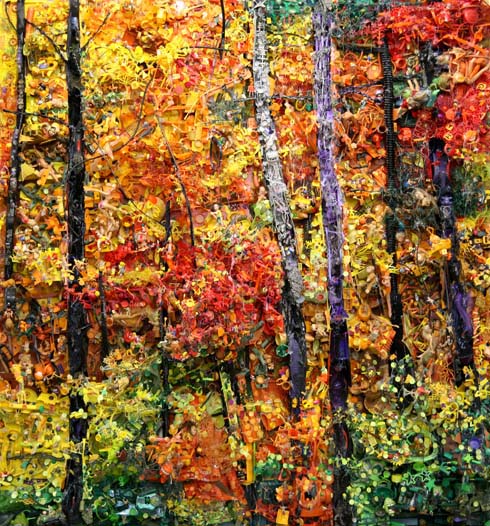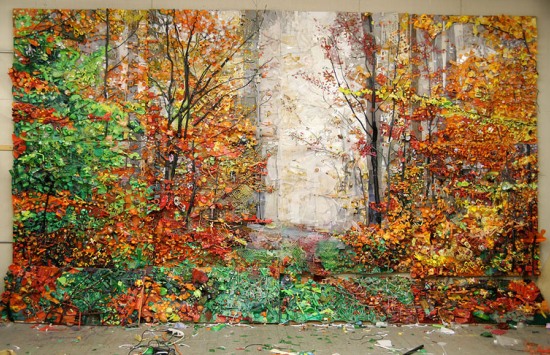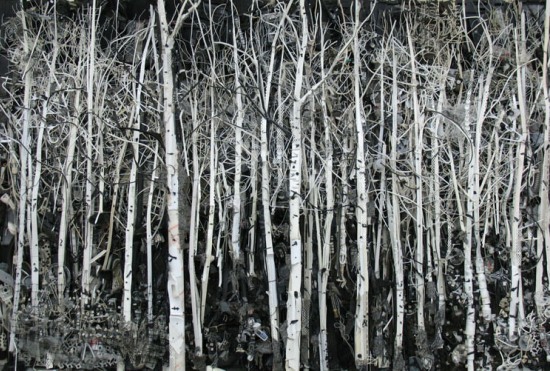
“Stroking Monet”
All images courtesy of Tom Deininger and used with permission.
Apart from the fact that it looks simply stunning, Tom Deininger’s work is interesting for us here at 1-800-RECYCLING because he uses materials that even many recyclers don’t want — stuff that’s nonrecyclable, nonbiodegradable or simply undesirable — all the while playing with our perceptions about what is and isn’t valuable. His giant junk landscapes are a case in point.
“Stroking Monet” detail

Deininger’s landscape junk assemblages depict idyllic landscapes and are made of junk, pure and simple. The artist explains: “I make my work out of found materials. Stuff that’s mostly nonbiodegradable and nonrecyclable. Bottle caps, lighters, combs, children’s toys, everyday plastics that we have — and I do it for a variety of reasons. One being environmental, but also [it’s about] perception.”
“Plastic Paradise” — 12’ x 20’

Looking like a real forest, “Fall Foliage” is a three-dimensional jungle; only instead of autumnal leaves, we are looking at discarded plastic in all shapes and sizes. Apparently discordant and dissimilar, the hundreds if not thousands of pieces integrate to form what seems — at least from afar — to be one homogenous forest.
“Fall Foliage”

For Deininger, his art is a comment on the value we place on things — even nature: “We tend to dismiss things that are inexpensive and don’t look at their beauty overall,” he says. “But when you can take something out of context and put it together with a variety of other things, you can coax a new definition out of it and maybe a new purpose.”
“Stroking Monet” detail

“Stroking Monet” (top, above and below) is probably Deininger’s best-loved and most recognizable landscape because it pays homage to Monet’s painting “Bridge over a Pond of Water Lilies” from 1899. Bear in mind that the impressionist’s works don’t look the same up close as they do from a distance, either. It’s fitting, then, that Deininger’s bridge, surrounded by dense greenery, looks so much like Monet’s original.
“Stroking Monet” detail

Continuing to talk perception, Deininger muses, “Perception is really the backbone of my work. I think that all art, even reality, is about perception. And so you’ve got one thing up close and it coalesces into something else all together from a distance. So, just the idea of what is reality, what is truth, has everything to do with perception… It reminds me of how slippery it can be, what is real and what is true.”
“Fourtune Brainstorm Green” — 10′ x 20′

“Fourtune Brainstorm Green” is a 20’ x 10’ backdrop commissioned for the conference, “Fortune Brainstorm Green,” held in California. Like “Fall Foliage,” the piece recreates the illusion of looking at a real forest, complete with beautiful fall colors. Upon closer inspection, of course, the viewers discover that the branches and leaves are actually not organic, but plastic. Too stunned to be disappointed, they then take a closer look and fully appreciate the plastic smell that should have been a dead giveaway — literally.
“Birch Pink”

“Birch Pink” is a work that was commissioned for the lobby of the building at 325 5th Ave. in New York City. By selecting only white, black and gray plastic pieces with a sprinkling of pink and orange thrown in, Deininger created a spectacular effect.
“Birch Pink” detail

As the detailed view shows, many different items were used: plastic mesh, little toy figures, plastic pipes and strips that simulate narrow tree trunks.
“Birch Pink” detail

It’s amazing how the apparent chaos and randomness of the arrangement up close straightens itself out upon stepping away and looking at the bigger picture. A hint to view life itself with a broader sense of perspective? Definitely.
“Poland Springs” — 8′ x 8′

“Poland Springs” is a piece that, as its title implies, is made of plastic detritus from the water bottle company, Poland Spring. It seems to symbolize the many promises that lure us into buying a product that, from an environmental point of view, doesn’t make much sense. (Bear in mind, for example, that it takes a full 3 liters of water to make just 1 liter of packaged water.)
“Ansele’s Aspens”

“Ansele’s Aspens” is a thick birch wood forest made out of white, gray and black pieces of discarded plastic. The effect from afar is remarkable; it looks so real that visitors might be tempted to wander among the trees.
“Ansele’s Aspens” detail

Upon taking a closer look, the orderly if somewhat sinister-looking birch trees again reveal themselves to be nothing but junk. Junk, but intriguing junk nonetheless. It’s clear that Deininger’s work is thought-provoking, upcycled art par excellence.
Boston-born Tom Deininger attended Salve Regina University in Newton, RI, and graduated with honors in art. By his own account, he spent his 20s “going from place to place setting up studios, selling artwork.” He returned to Newport in 1999 and took a studio in nearby Fall River, MA, where he started his large found-object artworks.
Deininger’s multifaceted works have been exhibited as part of many private and corporate collections all over the U.S. and worldwide. Make sure you take a look at his
website for more of his art. He never repeats the same theme, although the element of recycling and reuse is always present.
Additional sources: 1, 2, 3












